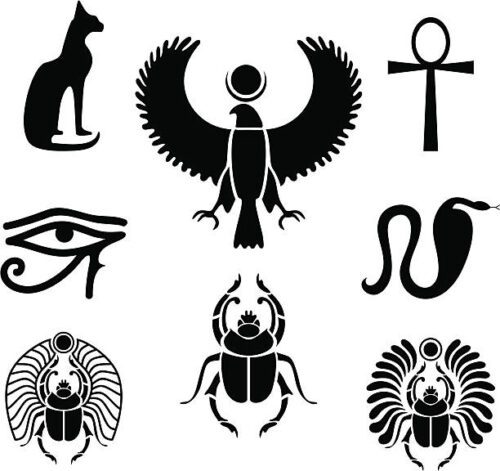
5 Egyptian Tattoos: Unveiling Ancient Symbols
Exploring Egyptian Tattoos: Ancient Symbols and Modern Interpretations
Tattoos have been a form of self-expression for thousands of years, and their significance varies across cultures and time periods. Among the most intriguing are Egyptian tattoos, which carry a rich history and deep symbolism. In this blog post, we’ll delve into the origins of Egyptian tattoos, their meanings, and how they continue to inspire modern tattoo art.
The Origins of Egyptian Tattoos
Ancient Practices
The practice of tattooing in ancient Egypt dates back to at least 2000 BCE. Archaeological evidence, including mummified remains, shows that tattoos were common among both men and women. The earliest known examples were found on female mummies, suggesting that tattoos may have had a protective or ritualistic purpose, particularly related to fertility and childbirth.
Symbolism and Purpose
In ancient Egypt, tattoos were more than mere decoration; they were imbued with symbolic meaning. Common motifs included:
- Lotus Flowers: Representing rebirth and the cycle of life, the lotus was a powerful symbol in Egyptian culture.
- Scarab Beetles: Associated with the sun god Ra, scarabs symbolized protection and transformation.
- Eyes of Horus: Known as the “Wadjet,” this symbol was believed to offer protection and health.
- Deities and Animals: Tattoos of gods, goddesses, and sacred animals were thought to invoke divine protection and favor.
Social and Religious Context
Tattoos in ancient Egypt were often linked to religious practices and social status. They could denote a person’s role within a religious cult or serve as amulets to protect against evil. Some scholars suggest that tattoos were also used to mark slaves or prisoners, although evidence for this is less clear.
Egyptian Tattoos in Modern Culture
Revival and Popularity
In recent years, Egyptian tattoos have experienced a resurgence in popularity. Their timeless symbols and rich history make them appealing to those seeking tattoos with deep meaning. Modern interpretations often blend traditional motifs with contemporary styles, creating unique and personalized designs.
Popular Egyptian Tattoo Designs
Ankh: The ankh, or “key of life,” is a popular choice for those seeking a symbol of eternal life and spiritual wisdom.
Eye of Horus: This symbol remains a favorite for its protective qualities and striking visual appeal.

Hieroglyphs: Many people choose to incorporate hieroglyphs into their tattoos, often spelling out names or meaningful words.
Pharaohs and Queens: Portraits of iconic figures like Tutankhamun or Cleopatra are popular for their historical significance and regal imagery.
Pyramids and Sphinxes: These symbols of ancient Egyptian architecture and mystery are often used to convey strength and endurance.
Cultural Sensitivity and Appropriation
While Egyptian tattoos are beautiful and meaningful, it’s important to approach them with cultural sensitivity. Understanding the historical and cultural context of these symbols is crucial to respecting their origins. For those outside of Egyptian culture, it’s advisable to research and reflect on the significance of the chosen design to avoid cultural appropriation.
Designing Your Egyptian Tattoo
Finding Inspiration
When considering an Egyptian tattoo, take time to explore the various symbols and their meanings. Books, documentaries, and museum exhibits can provide valuable insights into ancient Egyptian culture and art. Additionally, consulting with a tattoo artist who specializes in Egyptian designs can help bring your vision to life.
Personalizing Your Tattoo
To make your Egyptian tattoo truly unique, consider incorporating elements that hold personal significance. This could be a combination of symbols that represent different aspects of your life or a modern twist on a traditional design. Collaborating with your tattoo artist can result in a piece that is both meaningful and visually stunning.
Placement and Style
The placement of your tattoo can enhance its meaning and impact. Consider areas of the body that align with the symbolism of your chosen design. For example, a protective symbol like the Eye of Horus might be placed on the wrist or back of the neck. Additionally, think about the style of the tattoo—whether you prefer a realistic depiction, a minimalist approach, or a bold, graphic design.
The Tattooing Process
Choosing the Right Artist
Selecting a skilled tattoo artist is crucial to achieving the desired outcome. Look for artists with experience in Egyptian designs and a portfolio that reflects their expertise. A good artist will also prioritize hygiene and safety, ensuring a clean and professional environment.
Preparing for Your Tattoo
Before getting your tattoo, make sure to:
- Research: Understand the meaning and history of your chosen design.
- Consult: Discuss your ideas with your tattoo artist and finalize the design.
- Prepare: Follow any pre-tattoo instructions provided by your artist, such as avoiding alcohol and staying hydrated.
Aftercare
Proper aftercare is essential for the healing process and the longevity of your tattoo. Follow your artist’s instructions, which typically include:
- Keeping the area clean: Gently wash with mild soap and water.
- Moisturizing: Apply a recommended ointment or lotion to keep the skin hydrated.
- Avoiding sun exposure: Protect your tattoo from direct sunlight to prevent fading.
Conclusion
Egyptian tattoos offer a captivating blend of history, art, and personal expression. Whether you’re drawn to their ancient symbolism or their aesthetic appeal, these tattoos can serve as powerful reminders of the rich cultural heritage of Egypt. By approaching your tattoo with respect and understanding, you can create a meaningful piece that resonates with both the past and your personal journey.
Recent Posts
Edfu Temple :5 Reasons to Explore the Majestic Today
Discover 7 Amazing Features of Sinbad Hotel Egypt for 2024
Top 7 Reasons to choose Egypt Air Hospital in Egypt
All Categories
Tags

Thailand






